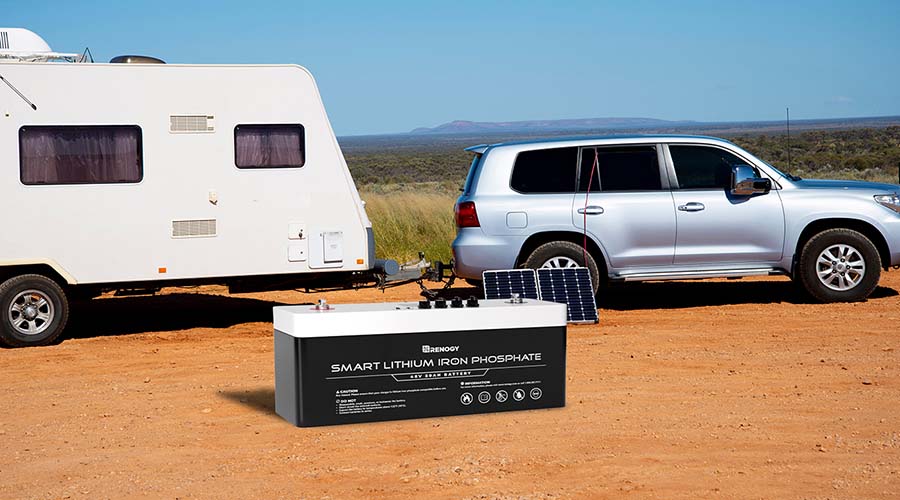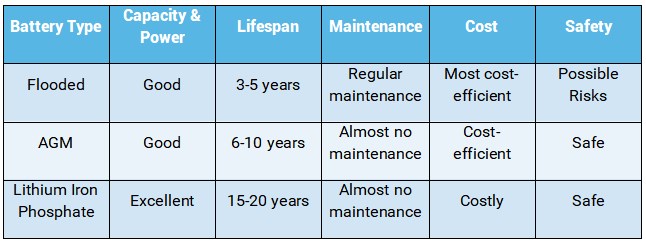What Is a Flooded Battery?
What Is a Flooded Battery?
Batteries are available in different types, and flooded batteries are a common type you can come across on the market.
Whether you are picking a battery for your boat, car, or backup power system, a flooded battery is a affordable option you want to consider. However, before investing in a flooded battery, you want to know what the battery is all about and what to expect.
This blog post explains what a flooded battery is, its use, and how long it lasts. You will also learn about the pros and cons of an flooded battery, among other questions surrounding the battery.
In this article, we will discuss:
- What Is a Flooded Battery?
- How Do Flooded Batteries Work?
- What Is A Flooded Battery Used For?
- Pros and Cons of Flooded Batteries
- How Long Does A Flooded Battery Last?
- AGM Vs. Flooded Vs. Lithium Battery
- Which Deep Cycle Battery Is Right For Me?
- Guide to Flooded Battery Maintenance
- FAQ
What Is a Flooded Battery?
A flooded battery works on the principle of a liquid electrolyte solution. A flooded battery, also known as a flooded lead acid battery or simply wet lead acid battery, consists of a liquid electrolyte solution covering all the battery's internal parts.
This definition is a good reason why the battery is also called a flooded lead acid battery, as it produces energy with the help of the liquid inside.
Another characteristic of a flooded battery is the availability of detachable caps attached to the top. The caps are necessary to pour distilled water into the battery when necessary.
It is also worth noting that if flooded batteries are overcharged, they let out gas through tiny vents.
How Do Flooded Batteries Work?
Inside the battery acid that fills the plastic container of a flooded battery are cells containing lead plates. These plates send positive and negative electric signals.
Charging a flooded battery triggers chemical and reverse chemical reactions between the battery cells and other components. These reactions then produce the electrical energy needed to power your appliances.

What Is A Flooded Battery Used For?
Flooded batteries produce electrical energy to power several machines and equipment.
For example, big and small automobiles such as motorcycles, cars, and trucks depend on flooded lead acid batteries to start up and move from one location to another. Owners of such automobiles would therefore be stranded without access to a flooded acid battery.
Flooded batteries are also adopted in the marine sector. Regardless of size, boats and vessels depend on flooded batteries to operate. Flooded batteries allow help power their boat engines and get them moving on and inside water.
Also, industrial settings that use electric and heavy-duty vehicles rely mainly on flooded batteries to power their vehicles and equipment.
In addition to the use of flooded batteries, the batteries are also used in the renewable energy sector. An example is UPS systems that require flooded batteries to store energy.
Also, you can find flooded batteries in solar batteries. Flooded batteries are useful in this application to store excess energy generated during the day from sunlight. People are able to make use of this stored-up energy in flooded batteries at night when the sun is not up.
Pros and Cons of Flooded Batteries
Flooded batteries have the following pros and cons:
Pros
Backup Systems: A flooded battery is your best option when in need of electrical energy backup storage. You can efficiently utilize the battery to save up excess power for later use.
High Efficiency: Flooded batteries are efficient. They can power most heavy-duty machines and automobiles without breaking down.
Affordability: A flooded lead acid battery will give you a better return on your investment in them as compared to other batteries. This is because you can buy them for as low as half the price you would buy others.
Ease of Maintenance: Wet lead acid batteries are very easy to maintain. Regular checks, cleaning, and topping of the distilled water are adequate to keep them in good working condition for a long time.
Cons
Regular Checks: Unlike dry cell batteries, flooded batteries comprise battery acid that requires regular checking and maintenance. You will need to top up the liquid if it falls below optimum levels. Unfortunately, there will be no need for such inspections for other battery options.
Low Durability: Flooded batteries have one of the shortest lifespans. Hence, you can’t use them for a long time as you would expect from other batteries.
High Risk of Hazard: Without proper care, flooded batteries can pose some hazards. For example, the liquid inside them can pour out if the battery is tilted. This is dangerous and can cause bodily harm.
Risk of Evaporate: The liquid inside flooded batteries is at a high risk of evaporating when exposed to extreme weather. Also, since flooded batteries produce gas when overcharged, damage can be done to the battery if there's no outlet for such harmful gas to escape.

How Long Does A Flooded Battery Last?
As hinted earlier, a flooded battery is not the best option when looking for a durable battery. A flooded lead acid battery typically lasts about three years, which is less than what other batteries offer.
However, a flooded battery can last longer for up to 5 years if well-maintained and not used too frequently.
The battery will also last longer if shielded from bad weather and high temperatures. Also, ensuring that it is not overcharged will help extend your flooded battery's lifespan.
AGM Vs. Flooded Vs. Lithium Battery
There are a few distinctions between AGM batteries and flooded batteries.
First, while AGM batteries and flooded batteries comprise a liquid, the liquid inside the AGM battery is sealed and cannot spill like the wet cell battery.
Also, AGM batteries can last for years without posing any hazards to their environment.
On the other hand, lithium batteries are dry cell batteries because they don't hold any liquid within them. They are lighter in weight compared to AGM and flooded batteries. And they charge faster and retain more power with each charge.
For safety, AGM and lithium batteries are safer to use than flooded batteries as they are sealed and don't require any ventilation to function optimally. You can also put them in any position without the fear of spilling harmful liquid.
Which Deep Cycle Battery Is Right For Me?
There are a few factors to consider when choosing the best deep-cycle battery. Start by looking for a deep cycle battery that can discharge up to 80%. You should also go for one that is sealed, as you won't be at risk of explosions or bodily harm.
Also, pay attention to the charging rate. A deep battery that charges fast and is very efficient with power usage is highly recommended.

Guide to Flooded Battery Maintenance
As highlighted earlier, it is important to properly maintain your flooded battery to eliminate the risk of hazards and ensure a longer lifespan. Here are a few tips for maintaining a flooded battery:
Regular Inspection
Inspect your battery regularly to ensure that it's in good working condition. While inspecting your battery, take time to check its exterior, making sure that the terminals are clean and not broken.
Also, ensure that the terminal connections are not well fastened and replace anyone that's damaged.
It would help to clean the battery top and rid it of any liquid using a metal brush or a clean piece of cloth.
Top up Distill Water Level
Always check the water level of your flooded battery. Ensure the water level doesn't go below the normal level. Top it up once you notice a considerable drop.
You can achieve this using distilled or deionized water made for the purpose. However, only top up battery water levels after you have previously charged them.
Avoid high Temperatures
As mentioned earlier, flooded batteries are prone to evaporating their liquid when exposed to high temperatures. Hence, it makes sense to keep your battery in a cool place.
FAQ
What Is A AGM Flooded Battery?
Absorbed glass mat (AGM) battery is an advanced lead acid battery. It's a battery type that comprises a non-spillable gel within.
As the name implies, AGM batteries utilize fiberglass mesh to separate the battery plates within and also to keep the positive and negative plates apart. They are a better option for people who desire wet-cell batteries.
Because the liquid within is well-sealed, it is safer to use. The inability of the liquid to spill also makes it possible to place AGM batteries in more flexible positions.
Also, AGM-flooded batteries are not capable of exploding or emitting dangerous gases when in use.
Can You Use A Flooded Battery With AGM?
It's not advisable to use an AGM battery with a flooded acid battery as they are designed to charge in different ways. While your battery will still charge if you use another type of battery charger on it, you will actually be doing harm to your battery, as such practices can reduce its lifespan.
It's best to use and charge each battery separately. Charging your batteries with their proper chargers and in line with the manufacturer's instructions would help elongate their lifespan.
Does a Flooded Battery Require Maintenance?
Yes, every battery type requires maintenance, and a flooded battery is not an exception. For flooded batteries, you must focus on ensuring the right water level, among other vital things you can do to care for them, as advised earlier.
How Do You Tell If a Battery Is Flooded Or AGM?
The first way to know if your battery is flooded or AGM is to read the information on the label. Every manufacturer ensures to make this information visible to prospective buyers.
However, in exceptional cases where you cannot easily tell a battery type from its label, you can look at how the top of the battery is built to tell what type it is.
An AGM battery is completely sealed and does not allow for any form of opening, while a flooded battery would have a cap with which you can open it. A flooded battery also has vents that allow the battery to breathe to prevent explosions.
Another means to differentiate AGM vs. flooded battery is to slightly shake the battery to ascertain if the liquid inside is moving or not. If it moves, then you've got a flooded lead acid battery. If the liquid doesn't flow, then you have an AGM battery.
However, shaking your battery to ascertain which type it is should be the last option and must be approached with caution.
Is A Flooded Battery Considered A Wet Battery?
Yes, a flooded battery is considered a wet battery because of the liquid in it. It's quite different from AGM batteries and dry-cell batteries.
Conclusion
A flooded acid battery is a common type of battery to find in different applications, from cars to boats to electrical energy backup. This blog post has provided you with all you need to know about flooded batteries.
It is only important to emphasize the need to properly maintain your flooded battery, as this is the only way to get the best performance of your battery. With regular cleaning and checking of the water level, you can keep your battery in good working condition.
If you have any questions about choosing a flooded battery, contact us at Renogy, and our experts will attend to you.
Related articles:
How Long Do RV Batteries Last? All About RV Batteries Lifespan
Solar Power Requirements: How Many Watts To Run A House In Canada?






